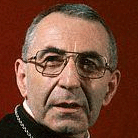| Sitemap | Ricerca | Contatto | | ||
 |
 |
 |
| Albino Luciani > Getuigenissen en anekdotes |
SIN, Jaime Lachica (1928-2005) Birth. August 31, 1928, New Washington, diocese of Kalibo, Philippines. The 14th of 16 children of a Chinese merchant, Juan Sin, and a Filipino woman, Maxima Reyes Lachica. He was educated in the faith by his mother, a woman of great religiosity who converted her husband to the Catholic faith before their marriage. He had a sense of humor about his name, often referring to his residence as "the house of Sin." Education. In 1941 he entered the Minor Seminary of St. Vincent Ferrer in Jaro, where he stayed for only a few months as the War of the Pacific and the Japanese occupation of the Philippines forced him to seek refuge with his family in the mountains for three years; St. Vincent Ferrer Archdiocesan Seminary, Jaro. Priesthood. Ordained, April 3, 1954, Jaro, by Antonio Frondosa, bishop of Capiz. His first pastoral endeavor was to visit each one of the hundreds of small widespread parishes and to inspire vocations for the new St. Pius X Seminary, 1954-1957. First rector of St. Pius X Seminary, Roxas City, 1957-1967; he also served as principal, dean of studies, professor and diocesan consultant. Domestic prelate of His Holiness, February 26, 1960. Episcopate. Elected titular bishop of Obba and appointed auxiliary of Jaro, February 10, 1967. Consecrated, March 18, 1967, cathedral of Roxas City, by Antonio Frondosa, bishop of Capiz, assisted by Juan Nilmar, titular bishop of Zapara, coadjutor with right of succession of Davao, and by Manuel S. Salvador, titular bishop of Nasbinca, auxiliary of Cebú. Apostolic administrator, sede plena, of Jaro, June 20, 1970. Promoted to the titular archbishop of Massa Lubrense and appointed coadjutor, with right of succession, of Jaro, January 15, 1972. Succeeded to the metropolitan see of Jaro, October 8, 1972. Transferred to the metropolitan see of Manila, January 21, 1974. Vice-President of the Catholic Bishops Conference of the Philippines January 1974. Cardinalate. Created cardinal priest in the consistory of May 24, 1976; received the red biretta and the title of S. Maria ai Monti, May 24, 1976. President of the Catholic Bishops Conference of the Philippines, January 1977; re-elected, July 1979 to 1981. Attended the IV Ordinary Assembly of the World Synod of Bishops, Vatican City, September 30-October 29, 1977; member of the general secretariat, 1977 - 1980. Participated in the conclave of August 25 to 26, 1978. Participated in the conclave of October 14 to 16, 1978. Attended the III General Conference of the Latin American Episcopate, Puebla, México, January 27 to February 13, 1979; the I Plenary Meeting of the Sacred College of Cardinals, Vatican City, November 5 to 9, 1979. Attended the V Ordinary Assembly of the the World Synod of Bishops, Vatican City, September 26 to October 25, 1980; member of the general secretariat, 1980-1983. Member of the Council of Cardinals for the Study of the Organizational and Economic Problems of the Holy See, May 31, 1981. Hosted the visit of Pope John Paul II to Philippines, 1981. President delegate, Jubilee Celebration Fátima, Portugal, 12 to 13 October 1981. Attended the VI Ordinary Assembly of the World Synod of Bishops, Vatican City, September 29 to October 28, 1983; member of the general secretariat, 1983-1986; membership extended until 1987 in the II Extraordinary Assembly of the World Synod of Bishops, Vatican City, November 24 to December 8, 1985. He played a decisive role in the "people power'' uprising that culminated with the overthrow of Ferdinand Marcos in 1986. Attended the VII Ordinary Assembly of the World Synod of Bishops, Vatican City, October 1 to 30, 1987. Hosted the second visit of Pope John Paul II to Philippines for the celebration of the Youth World Day, January 15, 1995 at Rizal Park, Manila, with the participation of four million people, the largest Christian gathering ever in history. In 2001, he led large street protests that provoked the fall of President Joseph Estrada, who was accused of corruption and misrule. His resignation to the pastoral government of the archdiocese of Manila for having reached the age limit was accepted, September 15, 2003. Apostolic administrator of the archdiocese of Manila, September 15, 2003 until November 21, 2003. He received several awards for his defense of human rights as well as thirty honorary degrees from colleges and universities throughout the world. Did not participate in the conclave of April 18 to 19, 2005 for reasons of health. Given the Golden Palm of Jerusalem, the highest award of service of the Equestrian Order of the Holy Sepulchre of Jerusalem on April 28, 2005, at Villa San Miguel, Mandaluyong City. Cardinal Sin was the first Filipino to receive this award. Death. June 21, 2005, at 6:17 a.m., at the Cardinal Santos Medical Center in San Juan, Metro Manila. Buried in the crypt beneath Manila's metropolitan cathedral on Tuesday, June 28, 2005, beside the tomb of Archbishop Gabriel B. Reyes, the first Filipino archbishop of Manila. Cardinal Rufino Jiao Santos, the first Filipino to be promoted to the cardinalate, is also buried in that crypt. Bibliography. Bautista, Felix B. Cardinal Sin and the miracle of Asia : a biography. Manila : Vera-Reyes, Inc., 1987; Bransom, Charles. "Philippine episcopology (IV. 1961-1970)." Boletín Eclesiástico de Filipinas, LXV, 718-719 (September-October 1989), 672. Link. Photograph, coat of arms and biography, in English.
http://www.fiu.edu/~mirandas/bios-s.htm#Sin
|
| ©2005 Webmaster |

